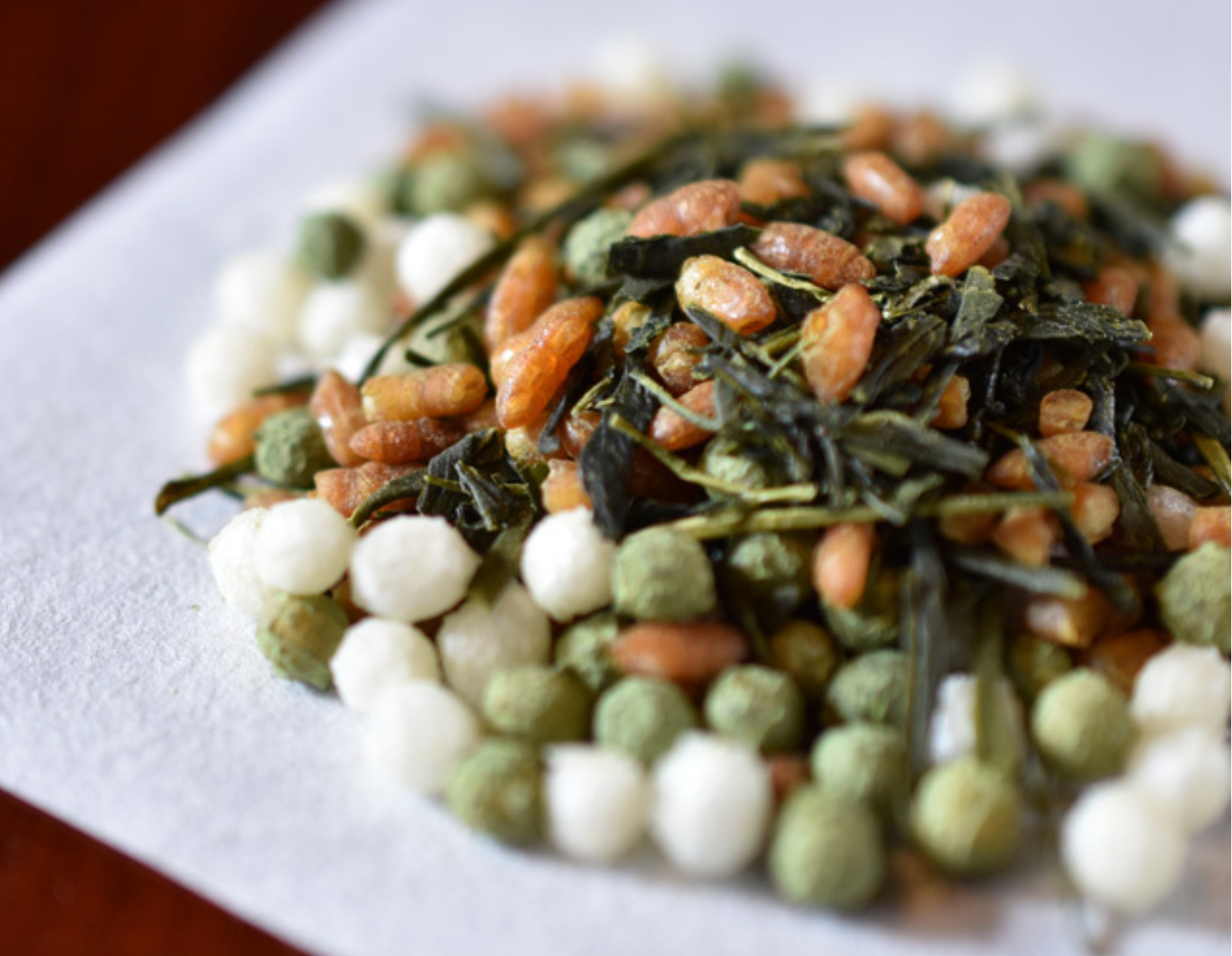As some of you may already be aware, November 1st was a day to celebrate Genmaicha day.
Genmaicha is a type of Japanese tea made by mixing sencha or bancha with roasted rice. By steeping this type of tea, the aroma of the roasted rice will be accentuated. There are various types of genmaicha but a 1:1 ratio of toasted rice and bancha is generally regarded to be the standard. It is also known as “brown rice tea” or “popcorn tea” due to the inclusion of popped rice kernels. My father-in-law calls it “rice krispies tea” and you may also have your own creative nickname for this tea.
To your pleasant surprise, you may find that genmaicha is often reasonably priced, as the tea that is used with the roasted rice is often slightly lower-grade, everyday tea leaves, rather than high end tea leaves (e.g., first flush). Of course, there are always the exceptions with some tea shops serving very high-quality genmaicha with the base tea being a high grade sencha or kabusecha (lightly shaded tea). Additionally, because it contains brown rice, the amount of tea leaves is reduced in comparison to the typical sencha. This means that a genmaicha has slightly lower caffeine content. Generally, sencha has less caffeine than coffee or black tea and genmaicha even less (although not zero!) so it is a friendly tea for those who are sensitive to caffeine and it is a tea that is considered a reasonable option for children. Perhaps, a nice aspect of genmaicha is that on top of the nice flavors of a regular sencha, you can also enjoy the aroma and toastiness of the roasted rice. In Japan, this tea is popular as an after-meal tea as it refreshes the palate.

Don’t forget to check out all the varieties of genmaicha on the Yunomi-site. Some are mixed with hojicha (photo on left) while others feature a dusting of matcha!
More about the roasted rice in genmaicha
While “genmai” (Japanese: 玄米) refers to brown rice, nowadays it is more common for genmaicha to have roasted white rice. People found that when brown rice was used, the flavor of the rice took over instead of the taste of tea. Some places use mochi rice in their mixed tea. How is the toasted rice prepared? In order to make the roasted rice, the rice is soaked in water overnight. Then, the water is strained the next day, and the rice is roasted until it is a nice golden brown color. The aroma of roasted rice is basically the aroma you smell released when steeping genmaicha. If you are open for the adventure, you can even make the roasted rice yourself and then add it to your favorite sencha or bancha! More recently, it has become possible to find the roasted rice sold separately in Japan, which again, you can mix into the tea you have at home. The roasted rice is said to be good eaten as is, just like arare, which are bite sized Japanese crackers.
Some genmaicha may have roasted rice that is white and looks like a flower. This is made from white rice that pops like popcorn. This is called ``Genmai Hana'' (hana means flower) and is used to brighten up the color of Genmaicha. Chiyonoen tea garden (Yame, Fukuoka Prefecture) has a very nice genmaicha with these flower shaped rice puffs.

Yabe-en Tea Shop has a unique genmaicha with rice cracker puffs (both plain and matcha flavored) which makes it beautiful in appearance but also adds to the toasty nutty flavor. Do you have a favorite genmaicha?
Roots of Genmaicha
Nowadays, Japanese people regard tea mixed with rice to be their standard genmaicha. However, if one traces the origins of this tea, this is not the case.
One story stated that early in the Showa period, a tea merchant in Kyoto glanced at a piece of kagami mochi (“mirror rice cake”) that had been broken at a kagami biraki (i.e., break the mochi into pieces festival) for New Year’s, and thought, “If only I could put these bits of mochi into good use…”. That’s when the idea originated to roast the small pieces of mochi and mix it into tea. Another story states this tea was started by adding the crunchy rice grains left in the pot after cooking rice to tea.
Although the exact origin story remains to be a mystery, there are several long-established tea tea shops in Kyoto that claim to be the originators of genmaicha, and it is said that they all started selling this type of tea at the end of the Taisho era to the early Showa era (1920’s). As a side note, this thinking of using food supplies and ingredients with care and without any waste reflects the mottainai concept that is deeply grained in Japanese culture. It may also be worth noting that kagami mochi is said to have a kami-spirit dwelling in it, and kagami mochi has long been thought of as a lucky charm for good health and prosperity. How the no-waste culture and lucky mochi came together in Kyoto, at the center of tea culture is intriguing in itself.
 Kagamimochi will be seen all over Japan around the time of the New Year, by PhotoAC.
Kagamimochi will be seen all over Japan around the time of the New Year, by PhotoAC.
As a final side note, while I was doing some research on the origins of this tea, I came across several entertaining theories or perhaps tall tales. One claimed genmaicha dates all the way back to 15th century Japan and originated when a servant named “Genmai” was pouring green tea for his samurai master. Genmai accidentally dropped brown rice from his sleeves into the cup of green tea for his master. The master was so angered that he beheaded the servant but drank the tea anyway, discovering that brown rice and green tea actually made a reasonable and delicious combination. Another close version of this story spares the life of the tea servant Genmai because the samurai warrior actually appreciated his servant. The mixed tea was drunk and the tea was named after the servant Genmai, as “genmaicha”.
Well, there seems to be plenty of fun stories to tell on the origins of genmaicha! Seasonally, this time of year (i.e., autumn) is a good time to enjoy genmaicha because it is rice harvest time. I hope that you learned something new about genmaicha today and that you may enjoy a cup of genmaicha in the not so distant future. Cheers!
Relevant Readings:
Featured image: Monoucha Genmaicha blends tea farmer Sasaki-san's sencha from Ishinomaki City (Miyagi Prefecture, northernmost tea region!) with toasted rice grains as well as rice cracker balls. Available from Yabe-en Tea Shop.


